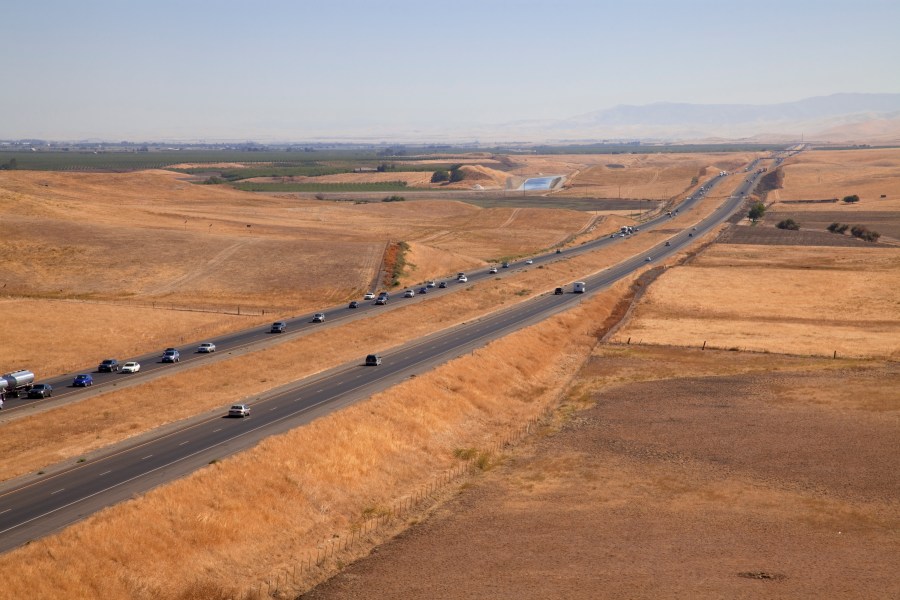If you’ve ever braved the long stretch of the 5 Freeway through the Central Valley where the heavily trafficked roadway is reduced to two lanes per side, you’ve probably found yourself in the middle of a long line of vehicles with no open lane in front of you.
It’s a common complaint among drivers, especially those who come from other states with strict rules and sarcastic signage about how to proceed on a multi-lane divided highway.
In some states, including Colorado and Illinois, drivers are prohibited from traveling in the left lane except if there’s an upcoming left-hand turn, or if they are overtaking another driver—provided that the passing vehicle is traveling at or under the posted speed limit.
The far right lane, and in instances when there’s an open middle lane, are meant for all other traffic.

In other states, including Washington, Montana and New Jersey, the rules are even more strict.
In those states, drivers are legally required to stay in the furthest-right lane at all times except when to overtake another vehicle or for an upcoming left turn. That means even if there’s a middle lane, you’re still required to stay as far right as possible and use the other lanes for passing.
But in California, as well as other parts of the country, the exact rules are a little bit unclear.
“There is not a specific vehicle code section or law that prohibits vehicles from essentially cruising in that left lane,” said Hector Carias, California Highway Patrol public information officer for the Central Division, which includes State Route 99 and several hundreds of miles of Interstate 5.
Technically speaking, you can drive in whatever lane you want provided you aren’t violating any laws—even when there’s only two available lanes in each direction. But this often leads to both lanes being occupied by vehicles traveling at near identical speeds, causing a backup.
California law does dictate that if you’re impeding the flow of traffic, you are required to move over, but that can be a little difficult to define.
The specific vehicle code states that you can be in the left lane provided you’re traveling within the “normal” flow of traffic.
Even then, “normal” doesn’t necessarily mean “legal.”
Most California drivers tend to think of the speed limit as a suggestion, and when they come up on a slower vehicle traveling in the left lane, they might get a little antsy to pass. But as long as that vehicle in the left lane is following the speed limit, it has every right to be there, even if other cars want to go faster.
“It’s kind of a little tricky,” Carias said. “Because if the flow of traffic is essentially what, 80 miles an hour, right? Essentially, you’re still in violation of the maximum speed limit.”
The speed limit, per CHP, is ultimately king when it comes to rules of the road.
“As long as they’re doing the speed limit. They’re not necessarily, per the law, impeding traffic,” Carias added. “California vehicle code doesn’t give someone the authority to exceed the maximum speed limit.”

Things can get even more complicated on roadways like Interstate 5 and Highway 99 when semi-trucks, which often solely occupy the right lane, attempt to pass another truck, and in the process back up the left lane and slow down dozens of passenger vehicles.
Those trucks are beholden to their own speed limit: 55 mph for any truck with three or more axles.
When a semi-truck ventures into the left lane, which, for truckers, is only permitted when passing in specific circumstances, they can cause a significant backup of passenger vehicles that are, more or less, following the rules of the road.
But, again, the state’s posted speed limit is there for a reason.
A semi, like other vehicles, is not entitled to speed in order to overtake a slower vehicle.
In fact, “you should almost never really see them in that far left lane,” Carias said.
So, what’s the verdict for passenger vehicles?
You might have the right to cruise (or camp) in the left lane, but for the sake of practicality and overall safety, you should probably think of it as a passing lane and move back over, even if it’s not technically the law.
According to CHP, that driving behavior is highly encouraged.
“It’s done in other states and in other countries where that left lane is designated a passing lane. That’s what they’re designed for,” Carias said. “And if everybody used it that way, that possibly could alleviate a lot of that congestion as well. But in California, it’s not the case. So we can encourage it as much as we can.”
But still, Carias says, the most surefire way to prevent traffic build up on California roadways is simple: drive the speed limit.
“If everyone could drive the same speed and give everybody the same amount of appropriate following distance … you probably would alleviate a lot of the congestion,” Carias said. “That’s how the roadways and everything is designed to work.”
Realistically, having all Californians drive at the same speed and give everyone room to breathe might be simply too much to ask.
So the very least they can do is pass on the left, then get out of the way for others. It might just make traffic easier on everyone.
